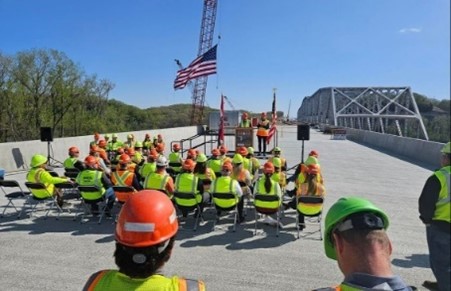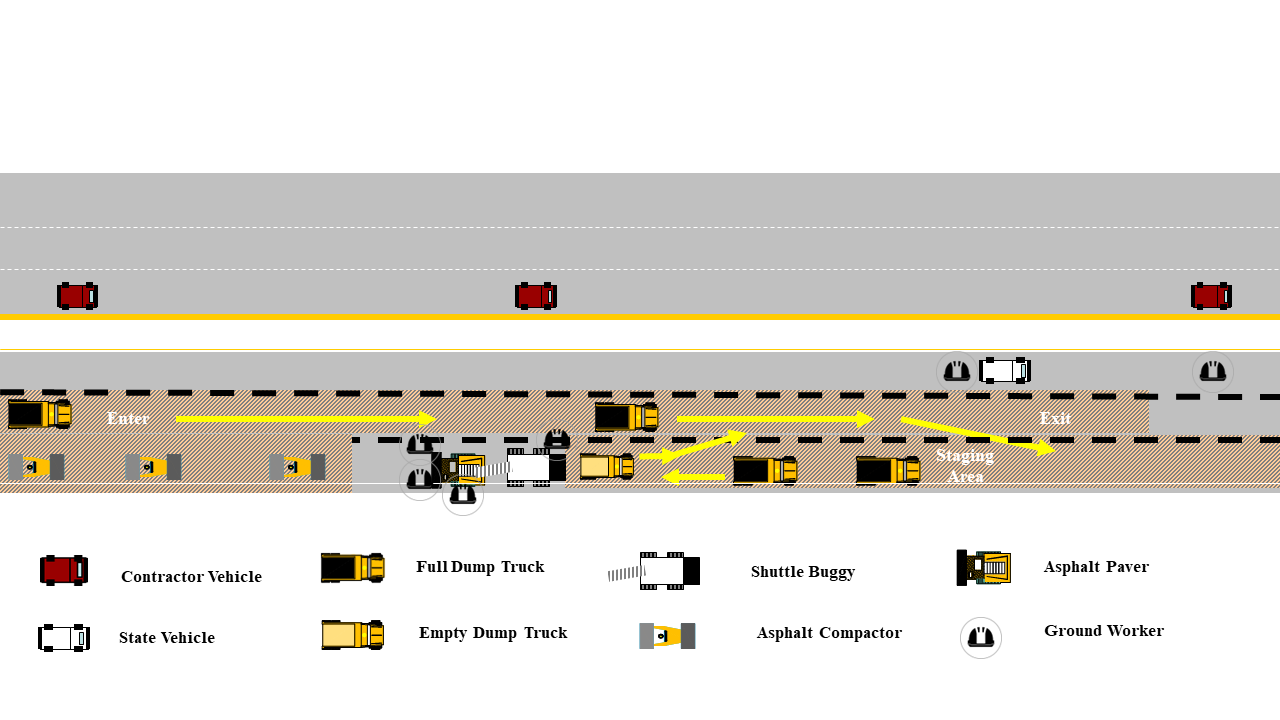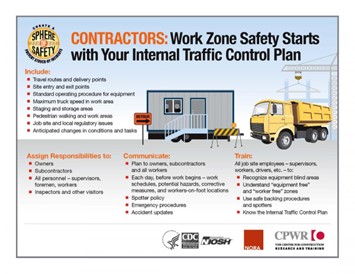Using Internal Traffic Control Plans to Prevent Construction Worker Injuries and Fatalities in Work Zones
Posted on by
Struck-by injuries are the leading cause of nonfatal injuries and second most common cause of fatalities among construction workers. From 2011 to 2022, there were 1,462 fatal occupational injuries that occurred at road construction sites .[1] Of these, 68% (n=1,000) were among workers in the construction industry (See figure) followed by workers in transportation and warehousing (11%; n=168) and professional and business services (9%; n=132) industries. Forty-four percent of the occupational fatalities at road construction sites (n=650) involved a worker struck-by a vehicle in a work zone. 1
National Safety Stand-Down to Prevent Struck-by Incidents

The National Safety Stand-Down to Prevent Struck-by Incidents is being held during this year’s National Work Zone Awareness Week, April 15-19, 2024. The week will kick off with a Stand-Down on Monday, April 15 in Mobile Alabama at 1:30 pm. Watch on YouTube.
A webinar, Developing and Enforcing Internal Traffic Control Plans, will be held on Thursday April 18, 2024, at 2:00 pm Eastern (1 hour) (REGISTER HERE). The webinar will include a panel of experts who will discuss practical and real-world issues related to use of Internal Traffic Control Plans (ITCP) to help protect workers in roadway work zones. National Work Zone Awareness Week is an annual campaign highlighting the risks faced by both workers and motorists in these dangerous work sites. A key message of National Work Zone Awareness Week is for all drivers to use extra caution and reduce speed in work zones. The National Safety Stand-Down to Prevent Struck-by Incidents focuses on the construction workers who are exposed to struck-by hazards from the general motoring public and the construction equipment that is operated within the work zone. Read on to learn more about reducing struck-by hazards for workers within the work zone through the implementation of an ITCP.
Overview of ITCPs
A temporary traffic control plan describes how a work zone should be designed to ensure the safety of the motoring public traveling through the work zone. However, temporary traffic control plans do not address construction equipment and vehicles within the workspace – these types of hazards are addressed in an ITCP.
An ITCP is a tool that can be used to coordinate and control the flow of construction vehicles, equipment, workers, and others entering and operating within the work zone. The purpose of an ITCP is to separate—to the extent possible—vehicles and equipment from on-foot workers and to prevent struck by incidents. ITCPs establish procedures tailored to the unique dynamics of construction activities within the work zone. A well-developed and clearly communicated worksite ITCP creates a safer work environment and prevents property damage and project delays.
A recent review of the National Institute for Occupational Safety and Health (NIOSH) Fatality Assessment and Control Evaluation (FACE) reports highlighted the importance of ITCPs.[2] In that review, among 75 reports investigating 78 roadway work zone fatalities, 41 (55%) incidents were directly related to construction vehicles and equipment operating inside the work zone. These incidents included equipment running or backing over victims and victims being caught in or between equipment. The authors discuss the potential for ITCPs to prevent fatalities that occurred within the work zone.
Regulations and Guidance for Work Zones
The U.S. Department of Transportation’s Manual on Uniform Traffic Control Devices establishes national uniform criteria for the use of traffic control devices to meet the needs and expectations of road users on roadways open to public travel. The manual is referenced in the OSHA regulation for construction signs, signals, and barricades (1926 Subpart G) specifically related to traffic control signs, devices, and signaling in work zones. The Department of Transportation’s Federal Highway Administration provides additional regulations that contain important worker safety directives. Subparts J and Subpart K (23 CFR 630) describe situations where positive separation between workers and motorists should be used, proper work zone access and egress design, procedures for employing uniformed law enforcement officers to control speeds, and required training for those who make critical safety decisions related to work zone management.
A10.47-2021 Work Zone Safety for Roadway Construction
The American National Standard Institute and American Society of Safety Professionals A10.47 is a national consensus safety standard that provides guidance for employers engaged in construction, utility work, and maintenance or repair activities on any area of a highway. The guidance applies to construction activities for any size company working on public and private highways or roadways. It applies to daytime, lowlight, and night-work conditions. Section 6.5 of this standard provides language on development of ITCPs.
Developing an ITCP
Resources are available to help contractors and project managers develop ITCPs for all types of work. For example, the American Road and Transportation Builders Association (ARTBA) provides an in-depth guide called Developing ITCPs for Work Zones. In this guide, ARTBA provides eight steps for developing an ITCP:
- Identify project and ITCP scope
- Determine the construction sequence during the project
- Determine locations and safe movements for vehicles, equipment, and workers within each operation and draw the basic work area diagram(s)
- Determine vehicle and equipment movements to and from each operation
- Determine safe movements for workers to/from and within each operation
- Assess and resolve potential conflicts between internal traffic and workers on foot
- Identify individuals who will need to understand and perform their work under the ITCP
- Develop the ITCP communication, monitoring, and enforcement plan
Materials on developing and using ITCPs are also available in a booklet from the Laborers’ Health & Safety Fund of North America and partners which provides an ITCP checklist and other user-friendly materials.
Sample ITCP Diagram

Adapted from a diagram developed as part of a NIOSH research project on preventing worker injuries from operating construction vehicles and equipment during hot-mix asphalt paving operations.
Communicating an ITCP
Once the ITCP is developed, it must be communicated to all employees at the worksite including construction vehicle drivers entering the worksite. Communication should occur before work begins and anytime the ITCP is updated. For workers on-site, this can be done during pre-shift huddles or through other worksite communication to on-site workers throughout the workday. For drivers who will be arriving at the worksite this should occur at the start of their day, at an off-site staging area (e.g., at the batch plant when trucks are loaded), or upon arrival.
We Want to Hear From You!
How will your workplace increase awareness of work zone safety during this year’s National Work Zone Awareness Week?
If you work in a roadway work zone, how are ITCPs used in your workplace?
Amber Trueblood, DrPH, is the Director of the Data Center at CPWR – The Center for Construction Research and Training.
David Fosbroke is a Research statistician with the NIOSH Division of Safety Research, Surveillance and Field Investigations Branch at NIOSH.
Ryan R. Papariello, GSP, is the Safety & Health Specialist with the Laborers’ Health & Safety Fund of North America.
Nancy T. Romano, MS, CSHM, is a Safety and Occupational Health Specialist and the FACE Project Officer in the NIOSH Division of Safety Research.
Scott Breloff, PhD, is a Senior Industrial Research Engineer in the NIOSH Division of Field Studies & Engineering and the Co-Coordinator for the Construction Program in the Office of Construction Safety and Health at NIOSH.
G. Scott Earnest, PhD, PE, CSP, is the Associate Director, NIOSH Office of Construction Safety and Health.
Douglas Trout, MD, MHS, is the Deputy Director, NIOSH Office of Construction Safety and Health at NIOSH.
Useful Tools and Resources
Websites
Highway Work Zone Safety | NIOSH | CDC
Documents
Internal Traffic Control Planning Instructor Guide – ARTBA 2013
Guidance: Developing Internal Traffic Control Plans (ITCPs) for Work Zones – ARTBA 2016
Internal Traffic Control Plans Booklet – Laborers’ Health & Safety Fund of North America
Building Safer Highway Work Zones: NIOSH Document 2001-128
OSHA Quick Card – Work Zone Traffic Safety
FACE Databases and Videos
NIOSH’s Fatality Assessment and Control Evaluation (FACE) Program is a research program designed to identify and study fatal occupational injuries. The goal of the FACE program is to prevent occupational fatalities across the nation by identifying and investigating work situation at high risk for injury and then formulating and disseminating prevention strategies to those who can intervene in the workplace.
Animated videos have been created by ARTBA from FACE investigations during Work Zone incidents. NIOSH FACE Animated Videos — Work Zone Safety Information Clearinghouse
References
[1] Bureau of Labor Statistics (BLS) [2024]. Census of Fatal Occupational Injuries (2011 Forward) Database. https://www.bls.gov/iif/data.htm.
[2] Al-Bayati AJ, et al [2022]. Managing work zone safety during road maintenance and construction activities: challenges and opportunities. Practice Periodical on Structural Design and Construction 28(1). https://ascelibrary.org/doi/10.1061/PPSCFX.SCENG-1212
Posted on by

